Smallpox in Druitt Town, 1881
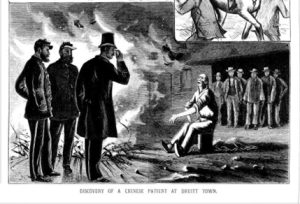
The Sydney Mail and New South Wales Advertiser 16 July 1881 p.105 https://trove.nla.gov.au/newspaper/article/161920550
In July 1881 smallpox came to Strathfield when a Chinese man named Sue Chong was found ill, hiding at a market garden owned by Mr Boyd in Druitt Town (now Strathfield South). He had been caring for another sick man in the city, escaped quarantine and fled west. Eight farm workers were escorted to the Quarantine Station at North Head and housed in tents (in winter), while Sue Chong was treated on board the ship Faraway.
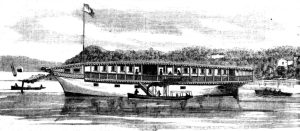
Hospital ship, Faraway. Sydney Mail 27 September 1884
Smallpox had arrived in Sydney during April 1881, possibly through more than one source.
On 29 April 1881 the steamship Brisbane arrived in Sydney from Hong Kong with 106 Chinese men and a cargo of oil, tea, cigars and opium, among other items.[1] The Brisbane headed to the Quarantine Station at North Head before unloading, with one man suffering from smallpox. He and a few others were moved to the hospital ship Faraway, moored at North Head. The remainder of the passengers stayed on board the Brisbane for several weeks.
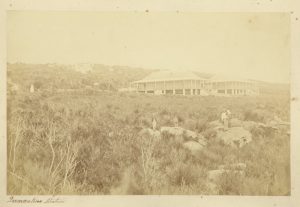
Quarantine Station, North head, c.1870s. Courtesy State Library of NSW
Three weeks after the Brisbane arrived, the small daughter of On Chong, a Chinese merchant from the Rocks, fell ill. With no clear diagnosis of the child, it was some time before quarantine was imposed on the family – and the doctors who had been monitoring the child.
Three weeks later another case was found in Surry Hills. Edward Rout had apparently been working on the roof of a building opposite On Chong’s house for several weeks before falling ill. His home, a lodging house, was placed under quarantine. Another boarding house in the Rocks was locked down the same day when one of Mr Keats’ lodgers also fell sick. Members of the public began reporting suspected cases to police. One report noted the suspicious activity of several Chinese men who had arrived at a Waterloo warehouse after dark. They were seen carrying a bundle resembling a body. When police visited they found Won Ping suffering from smallpox and the warehouse was quarantined. But one man was seen escaping.
With panic spreading as fast as the disease, the Government obtained a horse-drawn omnibus to move victims to Woolloomooloo, ready to be transported to the Quarantine Station. Here, entire families with small children spent a miserable night, cold and hungry. Mrs Rout accompanied her husband’s coffin, to be buried at the Quarantine Station. Two doctors who had treated smallpox sufferers were also exiled to North Head. Those who were sick, including Won Ping, were sent to the Faraway.
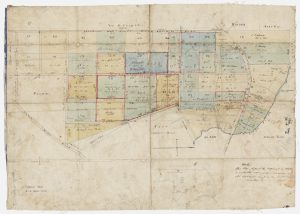
Bark Huts Estate, 1859. Two properties owned by James Boyd can be seen fronting Roberts Road near the centre of the map. Courtesy State Library of NSW
In Druitt Town, the arrival of a countryman seeking shelter caused no initial alarm although there was consternation when he became ill a week later. But it was another two weeks before the proprietor of the market garden at Boyd’s Farm, Laon Lee, travelled into the city seeking advice and the removal of the sick man hiding out in Strathfield. A number of doctors and police officers set out for the farm while Laon Lee was detained. When the party arrived in Druitt Town, some of the terrified farm workers ran and hid in the bush, but they were rounded up and all the workers were questioned – some roughly. Eventually the sick man was brought out of the cottage and examined – from a distance in the dark – by the light of a bonfire by Dr Hodson. The doctor was later forced to defend himself publicly, declaring that he had maintained a safe distance from the patient.[2] The Sydney Morning Herald commented on the remoteness of the cottage, noting that there was no other house within half a mile.[3] Authorities arranged for the omnibus to remove the eight men from the Druitt Town market garden to Woolloomooloo for transport to the Quarantine Station by the steamship Pinafore. However, owing to the rough state of the road near the farm, the bus broke down. Sub Inspector Larkins was forced to ride back to the city for a new pole to fix it.[4] Sue Chong was finally moved to the hospital ship Faraway while his friends were housed in tents at North Head.
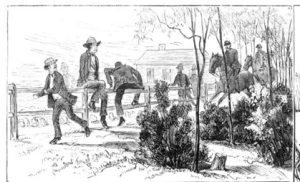
Police arriving at the market garden in Druitt Town, 1881. The Sydney Mail and New South Wales Advertiser 16 July 1881 p.105 https://trove.nla.gov.au/newspaper/article/161920550
In the days that followed several journalists expressed their dismay with the authorities in forcing the healthy farm workers to accompany their sick friend at close quarters on the journey to the city.[5] One writer to the Sydney Morning Herald agreed:
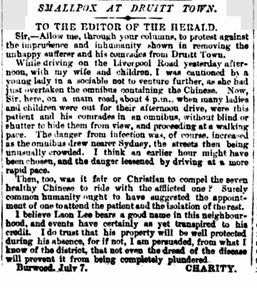
Sydney Morning Herald 8 July 1882 p.3 https://trove.nla.gov.au/newspaper/article/13489747
William West, Minister of the Congregational Church at Druitt Town also wrote to the newspapers:
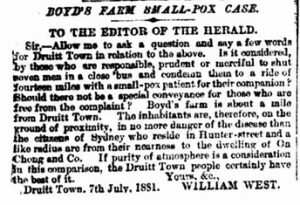
Sydney Morning Herald 9 July 1881 p.6 https://trove.nla.gov.au/newspaper/article/13489888
The case was debated in State Parliament, with several Members requesting that the Druitt Town farm be kept guarded and safe for the return of its occupants after quarantine. Lawlessness in a sparsely settled area was an ongoing threat.[6]
Although the plan to isolate those with symptoms, as well as others exposed, was valid, the result was flawed indeed. Those sent to the Quarantine Station suffered terrible privations during the outbreak. Supplies of linen, towels and medicines were often withheld. The Superintendent of the Quarantine Station was declared unfit for his post and a Royal Commission eventually stripped him of his job. One of the doctors on duty suffered a breakdown and had to be removed. The smallpox outbreak did not spread far but vaccination levels were low and supplies of the necessary cowpox lymph were limited. Immigration was also criticised since the first cases had appeared in the Chinese community although smallpox was then rife in western countries too.
The unfortunate farmers returned to Boyd’s Farm after being released from quarantine on 27 August.[7] Only Sue Chong had caught the disease. They were taken by steamer to Five Dock, making their way back to Druitt Town from there.
‘The place had been prepared for their return, beds and bedding of a much better description than those which they had been accustomed to had been procured by senior-sergeant Lenthall, and put into the place for their use, whilst an abundance of provisions were also awaiting them.’[8]
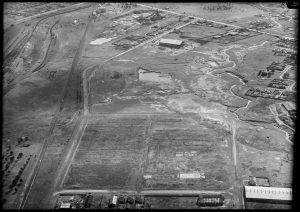
Milton Kent view of the Druitt Town and Enfield district, c.1923. Courtesy State Library of NSW
Of the 154 diagnosed cases of smallpox during 1881, there were 40 deaths. There was prolonged and serious debate in state parliament both during and after the epidemic.[9] The newspapers also featured accounts of their experiences from the constables and doctors on duty.[10] Recommendations and improvements were suggested for future public health emergencies.
It is unclear what became of Sue Chong after this time.
You can read a full account of Sydney’s 1881 smallpox epidemic by Raelene Allen at: https://dictionaryofsydney.org/entry/smallpox_epidemic_1881
By J.J. MacRitchie
Local Studies Advisor
References
[1] Allen, Raelene (2008) ‘Smallpox epidemic 1881’ in Dictionary of Sydney https://dictionaryofsydney.org/entry/smallpox_epidemic_1881[2] Sydney Morning Herald 8 July 1881 p.5 https://trove.nla.gov.au/newspaper/article/13489737
[3] Sydney Morning Herald 6 July 1881 p.6 https://trove.nla.gov.au/newspaper/article/13489601
[4] The Sydney Daily Telegraph 7 July 1881 p.3 https://trove.nla.gov.au/newspaper/article/238307066
[5] Sydney Morning Herald 8 July 1881 p.5 https://trove.nla.gov.au/newspaper/article/13489739/1422711
[6] The Sydney Daily Telegraph 8 July 1881 p.3 https://trove.nla.gov.au/newspaper/article/238310192
[7] The Sydney Daily Telegraph 29 August 1881 p.3 https://trove.nla.gov.au/newspaper/article/238310912
[8] Sydney Morning Herald 29 August 1881 p.6 https://trove.nla.gov.au/newspaper/article/13493570
[9] Sydney Daily Telegraph 31 August 1881 p.3 https://trove.nla.gov.au/newspaper/article/238307376
[10] Illustrated Sydney News and New South Wales Agriculturalist and Grazier 30 September 1881 p.14 https://trove.nla.gov.au/newspaper/article/64974601/5406517
